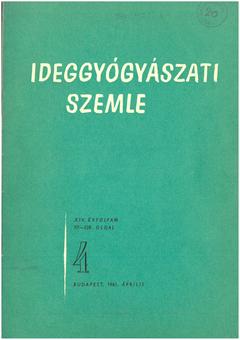The eLitMed.hu medical portal uses computer cookies for convenient operation. Detailed information can be found in the Cookie-policy.
Clinical Neuroscience - 1961;14(04)
Content
[Childhood spinal tumours]
[Detection of spinal tumours in children and differential diagnosis are often difficult problems. We have described the specific difficulties and confounding factors in childhood, which are mainly based on anamnestic data and neurological examination and neurological assessment. However, the CSF passage and laboratory examination, as well as the X-ray, can in most cases be used as a basis for at least suspecting a tumour and referring the child to a specialist hospital. If surgery is not performed, but the suspicion of a tumour persists, regular check-ups, preferably by the same doctors, are essential. Even with contrast procedures, exploratory laminectomy may be necessary in some cases. Evidence of spinal cord compression, even in the case of a suspected malignant tumour, requires surgical intervention, and infancy is not a reason for delaying the procedure. It is known that the success of surgery depends primarily on the nature of the tumour and the preoperative status, but experience shows that good results can be achieved with surgery not only in cases of juxtamedullary benign gliomas but also in intra-medullary gliomas. Temporary improvement can also be expected from decompression in malignant extramedullary tumours, where the duration of improvement may be prolonged by appropriate X-ray irradiation. ]
[Polyposis and palinopsia]
[Authors deal with two of the rarer visual illusions, polyopia and paliopsia. Polyopia or multiple vision is a spatial visualis persevaratio. It can be psychogenic or organic in origin. Organic polyopias can be subdivided into: 1. polyopias of ocular origin, 2. polyopias associated with nystagmus, 3. occipital (cerebral) polyopias. The authors describe examples of each of these three types. Palinopsia is a temporal visualis preservatio. The descriptions of palinopsia in the literature all show different features. In authors 3, palinopsia appeared as negative afterimages after prolonged television viewing. In case 4, a vascular laesio occurred in the area of the b. o. art. calcarina. During the improvement phase of cortical blindness and j.o. homonymous hemianopsia, polyopia, palinopsia, dysmorphopsia and spatial dysfunction were temporarily present. In our case, visual afterimages suggestive of an eidetic optotype were induced. The categorical inclusion of partial palinopias - i.e. projection to the adaequate location - is explained by the authors using Gestalt theory. Cerebral polyopia and palinopia are important occipital goitres. They are usually transient, part of a complex symptom complex. They are most often seen during the recovery phase of visual field damage, but radiatio optica laesio is not a prerequisite. The intimate relationship between polyopia and palinopsia is not only illustrated by case 4 of Pötzl (1954) and co-authors, where the two visual illusions occurred together. This relationship is also supported by the fact that polyopic subimages always occur in succession in time. The different polyopic phenomena are therefore based not only on spatial but also on temporal visual perseveration. Authors stress that one of the basic disorders of polyopia is palinopsic readiness. The latter is not identical with the prolongation of physiological afterimages. ]
[Brain tumours and tumour cysts Cholinesterase activity]
[By determining the AcKE and BuKE activity of 100 brain tumors and 50 tumor cysts, it was found that significant shifts in enzyme activity occur at each tumor endpoint, which are characteristic of tumor type. ]
[Treatment of status epilepticus with muscle relaxants and prolonged mechanical ventilation ]
[After touching on the pathophysiology and management of status epilepticus, the authors describe 3 cases in whom muscle relaxant and prolonged mechanical ventilation were used. Their experience is considered favourable.]
1.
Clinical Neuroscience
[Headache registry in Szeged: Experiences regarding to migraine patients]2.
Clinical Neuroscience
[The new target population of stroke awareness campaign: Kindergarten students ]3.
Clinical Neuroscience
Is there any difference in mortality rates of atrial fibrillation detected before or after ischemic stroke?4.
Clinical Neuroscience
Factors influencing the level of stigma in Parkinson’s disease in western Turkey5.
Clinical Neuroscience
[The effects of demographic and clinical factors on the severity of poststroke aphasia]1.
2.
3.
4.
5.



